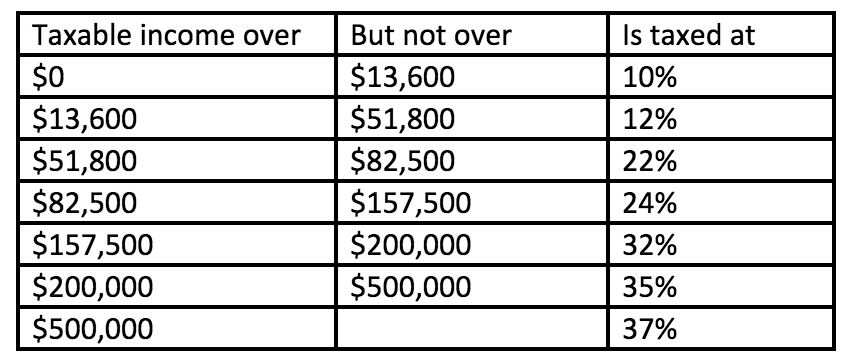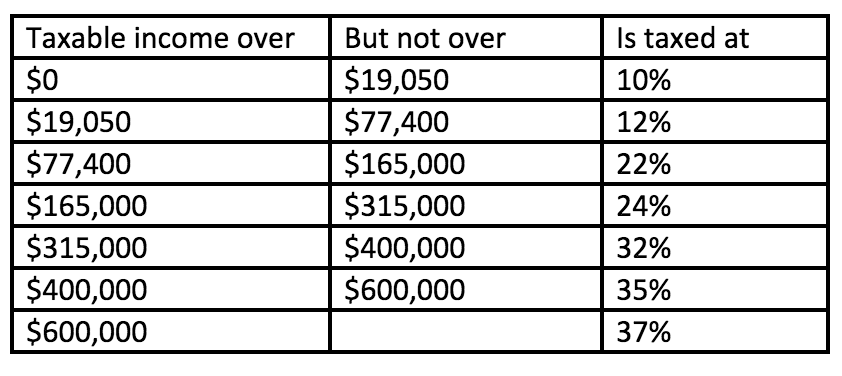2018 Tax Act High Points
What the Tax Reform Act Means for You
Key changes for individuals:
Here are some of the key items in the tax reform act that affect individuals:
- Reduces income tax brackets: The act retains seven brackets, but at reduced rates, with the highest tax bracket dropping to 37 percent from 39.6 percent. The individual income brackets are also expanded to expose more income to lower rates (see charts below).
- Doubles standard deductions: The standard deduction nearly doubles to $12,000 for single filers and $24,000 for married filing jointly. To help cover the cost, personal exemptions and most additional standard deductions are suspended.
- Limits itemized deductions: Many itemized deductions are no longer available or are now limited. Here are some of the major examples:
- Caps state and local tax deductions: State and local tax deductions are limited to $10,000 total for all property, income and sales taxes.
- Caps mortgage interest deductions: For new acquisition indebtedness, mortgage interest will be deductible on the indebtedness of no more than $750,000. Existing mortgages are unaffected by the new cap as the new limits go into place for acquisition indebtedness after Dec. 14, 2017. The act also suspends the deductibility of interest on home equity debt.
- Limit of theft and casualty losses: Deductions are now available only for federally declared disaster areas.
- No more 2 percent miscellaneous deductions: Most miscellaneous deductions subject to the 2 percent of adjusted gross income threshold are now gone.
Tip: If you’re used to itemizing your return, that may change in coming years as the doubled standard deduction and reduced deductions make itemizing less attractive. To the extent you can, make any remaining itemizable expenditures before the end of 2017.
- Cuts some above-the-line deductions: Moving expense deductions get eliminated except for active-duty military personnel, along with alimony deductions beginning in 2019.
- Weakens the alternative minimum tax (AMT): The act retains the alternative minimum tax but changes the exemption to $109,400 for joint filers and increases the phase-out threshold to $1 million. The changes mean the AMT will affect far fewer people than before.
- Bumps up child tax credit, adds family tax credit: The child tax credit increases to $2,000 from $1,000, with $1,400 of it being refundable even if no tax is owed. The phaseout threshold increases sharply to $400,000 from $110,000 for joint filers, making it available to more taxpayers. Also, dependents ineligible for the child tax credit can qualify for a new $500-per-person family tax credit.
- Expands use of 529 education savings plans: Qualified distributions from 529 education savings plans, which are not subject to tax, now include tuition payments for students in K-12 private schools.
- Doubles estate tax exemption: Estate taxes will apply to even fewer people, with the exemption doubled to $11.2 million ($22.4 million for married couples).
- Kiddie tax: Effective 2018, the “kiddie tax” on children’s unearned income will use the estates and trusts tax rate structure, meaning it will be taxed anywhere from 10 percent to 37 percent.
What stays the same for individuals:
- Itemized charitable deductions: Remain largely the same.
- Itemized medical expense deductions: Remain largely the same. The deduction threshold drops back to 7.5 percent of adjusted gross income for 2017 and 2018 but reverts to 10 percent in the following years.
- Some above-the-line deductions: Remain the same, including $250 of educator expenses and $2,500 of qualified student loan interest.
- Gift tax deduction: Remains and increases to $15,000 from $14,000 for 2018.
Farewell to the healthcare individual mandate penalty
One of the changes in the tax act is the suspension of the individual mandate penalty in the Affordable Care Act (also known as “Obamacare”). The penalty is set to zero starting in 2019 but remains in place for 2018 and prior years.
Tip: Retain your Form 1095s, which will provide evidence of your healthcare coverage. Without it, you may have to pay the individual mandate penalty, which is the higher of $695 or 2.5 percent of income. Beginning in 2019, this penalty is set to zero.
NOTICE: The IRS recently granted employers and health care providers a 30-day filing extension for Forms 1095-B and 1095-C, to March 2, 2018. The IRS clarified that taxpayers are not required to wait until receipt of these forms to file their taxes.
New 2018 tax bracket structures for individuals
Single Member
Head of Household
Married Filing Jointly
Married Filing Separately
Estates + Trusts
Key changes for small businesses:
Here are some of these key items in the tax reform act that affect businesses:
- Cuts the corporate tax rate: Corporate tax gets cut and simplified to a flat 21 percent rate, changed from a multi-bracket structure with a 35 percent top rate.
- Reduces pass-through taxes: Most owners of pass-through entities such as S corporations, partnerships, and sole proprietorships will see their income tax lowered with a new 20 percent income reduction calculation.
- Beefs up capital expenses: Through 2022, short-lived capital investments in such items as machinery and equipment may be fully expensed as soon as they are placed in service, using bonus depreciation. This now also applies to used items instead of only new ones; they just need to be placed in service for the first time in your business. After 2022, allowable bonus depreciation is then lowered incrementally over the next four years.
- Strengthens Section 179 deduction: Section 179 deduction limits get raised to enable expensing of up to $1 million, and the phaseout threshold increases to $2.5 million. Section 179 may now also be used for expenses related to improvements to the nonresidential real estate.
- Nixes the corporate alternative minimum tax (AMT): The 20 percent corporate AMT applied to businesses goes away entirely.
- Expands use of cash-method accounting: Businesses with less than $25 million in gross receipts over the last three years may adopt the cash method of accounting.
- Reforms international taxation: Treatment of international income moves to the territorial system standard, in which foreign investments are generally only taxed in the place in which they operate. The new laws allow tax deductions for certain foreign-sourced dividends, reduced tax rates for foreign intangible income and reduced tax rates for repatriation of deferred foreign income.
- Repeals business entertainment deduction: Businesses will no longer be able to deduct 50 percent of the cost of entertainment, amusement or recreation directly related to their trade or business. The 50 percent deduction for business-related meals remains in place, however.
- Modifies several business credits: Several business credits are maintained but modified, including the orphan drug credit, the rehabilitation credit, the employer credit for paid family or medical leave and the research and experimentation credit.
- Boosts luxury automobile depreciation: Luxury automobiles placed in service after 2017 will have allowable depreciation of $10,000 for the first year, $16,000 the second, $9,600 the third and $5,760 for subsequent years.
This is merely a summary of the act and to better understand the detail and how it affects you or your company, please contact me at 713-243-8590 or gcooper@coopercpagroup.com.





